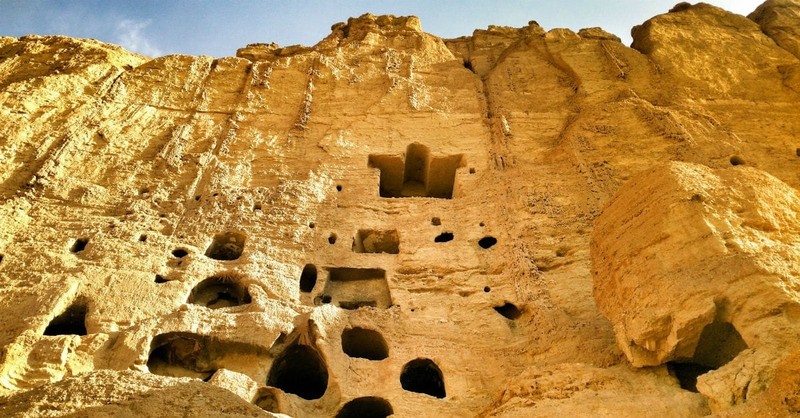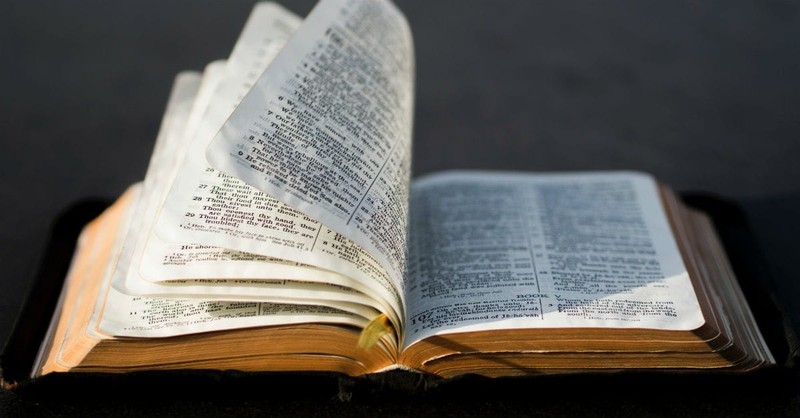Where in the Bible Does It Talk About Weed
What Is the Bible and Where Did it Come From?
- Emily Hall Salem Web Network
- 2018 30 May

What is the Bible? It's been both enforced and banned by governments. It's the most debated, respected, hated, and loved book in the world. It's the Word of God, recorded over about 1,500 years by 40 authors.
The Holy Bible is one massive book containing 39 individual books in the first part, called the Old Testament (OT) and 27 in the second part, the New Testament (NT). All together you get 66 books telling the grand narrative of God redeeming mankind.
"There is little doubt that the Bible is the world's best-selling and most widely distributed book," according to Guinness World Records.
It's popular, sure. But can we trust its authenticity? And how did we get this book? I know you got yours at Lifeway, but have you ever wondered, "Where did the Bible really come from?"
Photo Credit: Unsplash/Priscilla du Preez

Do Americans trust the Bibles on their bookshelves?
Over the past few years, researchers and statisticians have been telling us that Americans' feelings about the Bible are…complicated.
Barna Group's 2017 State of the Bible report gave Christians a reason to feel more hopeful about the spiritual state of their neighbors. They found that 87% of American households own at least one Bible. But Lifeway released a 2016 report about how Americans think about that Bible sitting on their bookshelf. Their report said that only 47% of Americans described the Bible as completely accurate.
Pew confirmed in its 2018 report that many Americans are unsure about the trustworthiness of their Bibles. The Pew report revealed that while 80% of Americans believe in "God," only 56% believe God "as described in the Bible."
It seems as though even if people are curious enough to buy a Bible (or amybe just respectful enough to keep one given to them), they still might not believe it. Hopefully understanding where the Bible comes from helps. Here are some snapshots throughout history about how the Bible came to be.
Photo Credit: Unsplash/ Alfons Morales

How did we get the Old Testament?
There wasn't much debate about what books were considered part of the OT because the Jewish people already accepted and organized those Scriptures. Leaders read them in the Temple and later in synagogues all over Israel and the Roman Empire.
But if you feel doubt about our modern leather-bound OTs, what people discovered in 1946 just might settle it for you. Eric Metaxas talks about this in his video for The Curiosity Collective.
"We live in a time where you keep hearing stuff like, 'Oh the Bible was changed in the Middle Ages by the monks,' and that we don't know what [the Bible] really says. Upon investigation, that's not true," he said.
Photo Credit: Unsplash/ Kira Auf Der Heide

"The argument that the Bible has changed has to go in the garbage, instantly."
When local shepherds discovered the Dead Sea Scrolls in Israel in 1946, archaeologists began investigations and confirmed that these ancient scrolls of paper were Bible manuscripts.
"[The Dead Sea Scrolls] are documents of the OT that had been hidden in jars in the desert, where it's dry, where they're preserved, for two thousand years," Metaxas said. "We don't have to guess whether the monks changed it or not, let's just read it. It's letter for letter the same as it is today.
"The argument that the Bible has changed has to go in the garbage, instantly. 100 years ago people could make arguments, but now we have archaeological evidence that keeps coming up. They had no evidence that 3,000 years ago there actually was a king in Israel named David – now they have archaeological evidence," he said, referring to the discovery of King David's palace in 2005.
"These manuscripts contain material now considered to be part of the Hebrew Bible. Every book is represented among the Dead Sea Scrolls, except the book of Esther. These are the oldest known copies of biblical works," according to The Leon Levy Dead Sea Scrolls Digital Library.
Photo Credit: Pexels/ Ali Yasser Arwand

How did we get the New Testament?
The New Testament came together a little differently and is probably the more debated section of the Bible. When the prophets like Jeremiah, Daniel, and Hosea wrote scripture, Jewish people did not tend to question if it was from God. However, NT writers like Paul experienced a different story. Their gospel accounts and letters were more debated when the church was agreeing on the canon of Scripture.
"In the New Testament, it's a little bit more of a process," Timothy Paul Jones said in his video, How Was it Decided Which Books Would Be put in the Bible? "But it's not the process we sometimes see when we're watching documentaries that supposedly tell us how the books of the Bible came about. There was a very clear vision from the earliest stages of church history about what types of books are the books that Christians –the church– should view as authoritative."
Watch the rest of the video here:
Photo Credit: Unsplash

"The memoirs of the apostles were considered as important to the teaching of the church as the writings of the prophets."
After Jesus Ascended to heaven, the church would gather to read Scripture together and pray. As the gospels, Paul's letters, and other NT books were written, the church would read those in gatherings as well. Justin Martyr, a Christian apologist, wrote about these gatherings in 150 A.D. "By this early date, the memoirs of the apostles were considered as important to the teaching of the church as the writings of the prophets," according to a BibleStudyTools.com article, "Who Decided What Went into the Bible?"
But over time, some churches didn't like reading Hebrews, and another church didn't like reading Revelation. There were even influencers who completely rejected the OT or tried to add new prophecies. Controversies like these pushed church leaders to question and settle which books were truly inspired by God. They used a set of guidelines to recognize which books belonged in the NT "canon." Lifeway's article, "Establishing the New Testament Canon," talks about three guidelines:
Photo Credit: Unsplash/Aaron Burden

"These guidelines helped unify the church."
- "Apostolic Origin: The early Christians essentially asked, 'Is this particular work under question the work of one of the apostles?' Or, 'If it is not the work of the apostle himself, was it produced under the supervision of and with the stamp of approval of one of the apostles?'
- Recognition by the Church: If the churches at Ephesus, Jerusalem, Antioch, Rome, and Carthage, for example, accepted a book as authoritative, then chances were strong that the church as a whole would give it serious consideration for inclusion.
- Apostolic Content: This criterion asked whether a book's content agreed with the doctrine the apostles taught when they were still alive. If anything was contrary to the apostles' actual teaching, it was considered not the Word of God."
These guidelines helped unify the church and the NT, then a few different events in the 4th century made it all official.
"In 367 [A.D.], Athanasius, the bishop of Alexandria, wrote an Easter letter that contained all 27 books of our present New Testament. In 393 [A.D.] the Synod of Hippo affirmed our current New Testament, and in 397 [A.D.] the Council of Carthage published the same list," according to the BibleStudyTools.com article.
Photo Credit: Unsplash

Who wrote the Bible?
According to BIbleinfo.com, God used 40 people to write down his words. Most of those writers didn't know each other, and they came from different backgrounds ranging form shepherds and fishermen to prophets and kings.
Here's an alphabetical list of each author and the book(s) they wrote.
But really, it was God who wrote the Bible, right?
Eric Davis talks about the Bible as the inspired Word of God in his article, "What Does it Mean that the Bible Was 'Inspired?'"
"It does not mean that Scripture is merely the product of significant human achievement. Instead, inspiration means this: God the Holy Spirit superintended the human writers of the 66 books of the Bible such that what they wrote were God's inerrant words to humanity in the original writings. In doing so, God did not violate the respective personalities, abilities, and contexts of the human authors from which they wrote. God acted upon them in a real context, with real need, to exercise his care for his people, with the result that the 66 books of the Bible are the without-error revelation of God in their original writings."
Photo Credit: Unsplash/Aaron Burden

What about the Apocrypha?
A BibleStudyTools.com article talked about how different Christian groups viewed these books:
"Outside the Holy Land some Jews included twelve to fifteen other books as part of Scripture, [what] we now call the Apocrypha. (Apocrypha means "those hidden away.") Early Christians differed over whether these extra books should be considered Scripture or not. Those nearest Palestine tended to exclude them. Those closer to Rome tended to include them.
During the sixteenth-century Reformation, Martin Luther spoke strongly against the Apocrypha. In reaction the Roman Catholic Church convened a council in Trent, where they declared the Apocrypha to be canonical. To this day Catholics and Protestants disagree on this issue. Catholics uphold the Apocrypha. Protestants believe that the Apocrypha is useful but not inspired."
Photo Credit: Unsplash/Alex Sorto

The Bible from Aramaic to English and beyond!
New Testament authors likely spoke Aramaic at home, Hebrew in "church," and Greek at work. While the OT books were written in Hebrew, the NT books were written in Greek to reach the whole Roman Empire, beyond the Hebrew-speaking Jews, "but some populations in the Empire knew no Greek," Christianity Today reported. "Thus, early translations appeared in various languages, notably Latin (becoming the standard language of the Western Empire), Syriac, and Coptic. Despite the early translators' zeal, they didn't always possess a good command of Greek. Soon many Old Latin manuscripts, poor in quality and often differing from each other, were in circulation."
Saint Jerome, who had a great command of the Biblical Greek and Hebrew languages, finished his Latin translation in 405 A.D. That translation is called the Vulgate, and it made the Bible more accessible to literate people in the Roman Empire. Liturgy and art helped share the Bible's message and themes to the illiterate. After the Roman Empire fell and English began to replace Latin as a standard language in the West, this Latin translation played a huge role in keeping the Bible accessible to as many people as possible.
"The influence of Jerome's scholarly work is felt today," Cary Summers, President of the Museum of the Bible said in this video. "When the Bible was first translated into English, it was based in large part on Jerome's Latin Vulgate."
Wycliffe Global Alliance reported that by the end of 2017, the complete Bible has been translated into 670 languages, and at least some of the Bible has been translated into 3,312 languages. Still, there is work to be done. "Over 114 million people, speaking 1,636 languages, are likely to need some form of Bible translation to begin," they reported.
Photo Credit: Thinkstock

A few bonus facts about the Bible:
- The shortest verse in the Bible is John 11:35, "Jesus wept."
- The longest verse in the Bible is Esther 8:9, "At once the royal secretaries were summoned—on the twenty-third day of the third month, the month of Sivan. They wrote out all Mordecai's orders to the Jews, and to the satraps, governors and nobles of the 127 provinces stretching from India to Cush. These orders were written in the script of each province and the language of each people and also to the Jews in their own script and language."
- John Wycliffe was the first to translate the entire Bible into English from the Latin Vulgate.
- William Tyndale made the first printed copy of the New Testament in English.
- The world's tiniest Bible is about the size of the tip of a pen.
- The world's largest Bible weights over 1,000 pounds.
Photo Credit: Unsplash

Editor's Picks
Where in the Bible Does It Talk About Weed
Source: https://www.crosswalk.com/faith/bible-study/what-is-the-bible-and-where-did-it-come-from.html